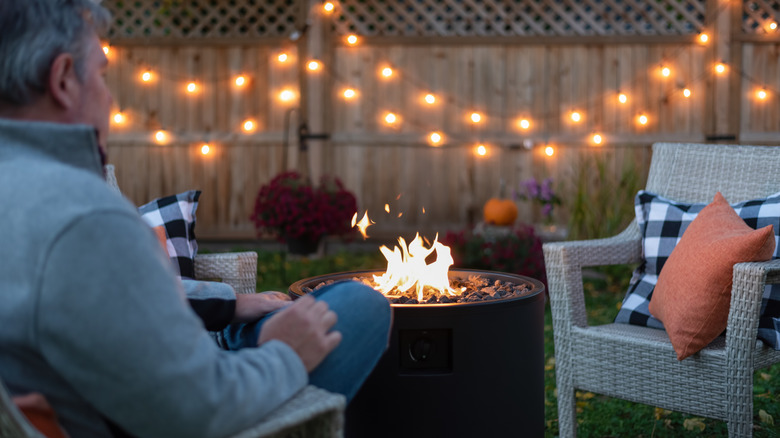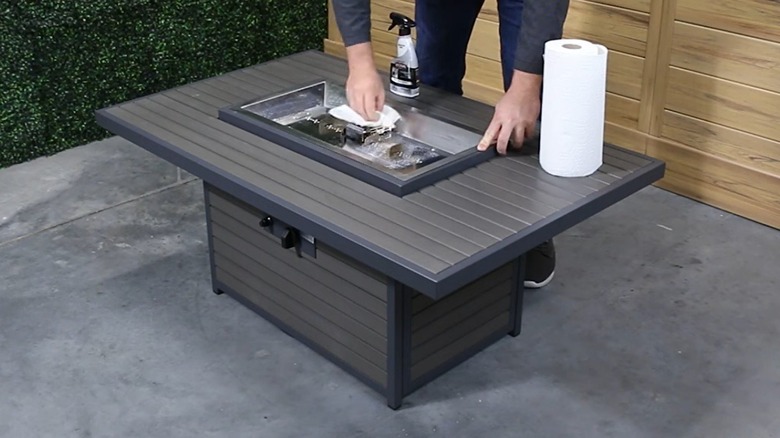How To Winterize Your Outdoor Gas Fire Pit Correctly
Fall's lower temperatures are usually a relief after several months of summer heat, but they're also a reminder that winter is on its way. Prepping your home for cold weather is crucial, especially if you live in an area that receives heavy snowfall. Unfortunately, while you may remember to clean the gutters, have your furnace serviced, and turn off exterior faucets, some outdoor spots are easy to overlook — namely, that beautiful gas fire pit that keeps you warm on cozy autumn nights. Winterizing your outdoor gas fire pit isn't difficult, but it requires a little work — disconnecting the gas, cleaning it, removing its accessories, and covering or storing it for the winter — if you want to ensure that it's ready to enjoy next year.
While fire pits are designed to withstand the elements, including rain, winter weather can be particularly brutal. Snow, ice, and gusty winds can cause significant damage to a gas fire pit, which can shorten its lifespan. Metal components might rust, pit, and corrode, while stone or tile details are vulnerable to cracking. Moisture from rain and snow that gets inside the fire pit's burner and ignition system can also make it more difficult to light when the warmer weather rolls around.
Disconnect the gas and clean the fire pit
While your fire pit can turn your outdoor living space into the perfect oasis, it takes quite a beating during the summer and fall months when you use it regularly. You should clean it thoroughly before winter to ensure that its burner and ignition system doesn't become clogged with debris (or a possible home to rodents and other pests). Before you begin cleaning, though, it's essential to disconnect the fire pit from the gas supply, so you can safely winterize it. In most cases, you'll need to close the valve on the gas line. For propane models, you should also remove the tank. If your fire pit has an electronic ignition, remember to turn off the circuit breaker, too.
Once the gas supply is turned off, remove any debris that has accumulated in or around your fire pit. Leaves and twigs can easily clog its burner ports and cause damage during the winter, so be sure to use a nylon brush or a can of compressed air to clean these holes carefully. It's also a good idea to clean the exterior of the pit with warm, soapy water and a soft brush.
Cover or store the fire pit
Once your fire pit is clean, remove any detachable accessories, such as a wind shield or decorative logs. These components are also vulnerable to the harsh winter weather, so store them in a secure, protected location, such as a garage, shed, or basement. If your fire pit is moveable, you can also store it in your garage or shed to ensure that it's fully protected from winter weather, which will help it last longer.
For built-in gas fire pits or those that are too large to move, a high-quality cover is essential. It shields the pit from rain, snow, and ice and prevents debris from blowing into it on windy days. Excessive moisture can also cause your fire pit to rust over the winter. Choose a UV-resistant, waterproof cover that fits securely, so it won't blow off on the first windy day. You can find vinyl, polyester, canvas, and even metal covers that work well.
However, even with a cover, your fire pit may be susceptible to potential moisture damage. That's why it's also important to remove snow and ice from around the pit promptly. If it has a chance to pile up, moisture may leach into the pit and its components, causing rust, corrosion, and other damage.


